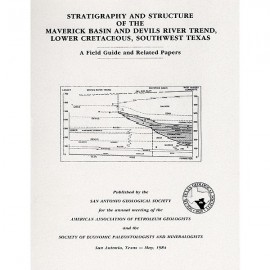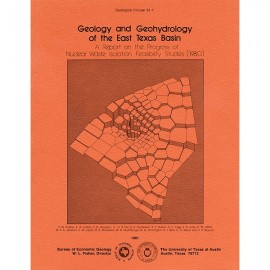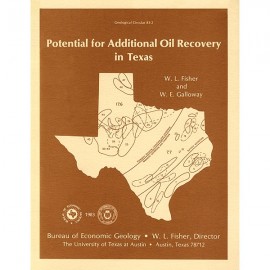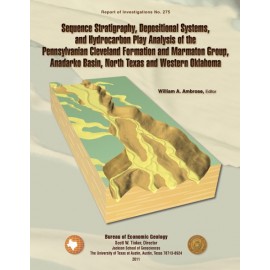Geological Circulars
-
Books & Reports
- Reports of Investigations
- Guidebooks
- Udden Series
- Geological Circulars
- Down To Earth
- Atlases of Major Oil and Gas Reservoirs
- Texas Memorial Museum Publications
- Environmental Geologic Atlas of the Texas Coastal Zone
- Mineral Resource Circulars
- Other Reports
- Seminars and Workshops
- Handbooks
- Submerged Lands of Texas
- Symposia
- Annual Reports
- Open File Reports
-
Maps & Cross Sections
- Thematic Maps
- Miscellaneous Maps, Charts & Sections
- Geologic Atlas of Texas
- STATEMAP Project Maps
- Geologic Quadrangle Maps
- Cross Sections
- Highway Geology Map
- Energy and Mineral Resource Maps
- Shoreline Change and Other Posters
- Wilcox Group, East Texas, Geological / Hydrological Folios
- Bouguer Gravity Atlas of Texas
- River Basin Regional Studies
- Featured Maps
- Posters
- Teachers & the Public
-
Geological Society Publications
- Gulf Coast Association of Geological Societies
- Alabama Geological Society
- Austin Geological Society
- Corpus Christi Geological Society
- Houston Geological Society
- Lafayette Geological Society
- Mississippi Geological Society
- New Orleans Geological Society
- South Texas Geological Society
- GCS SEPM Publications
- Historic BEG & UT Series
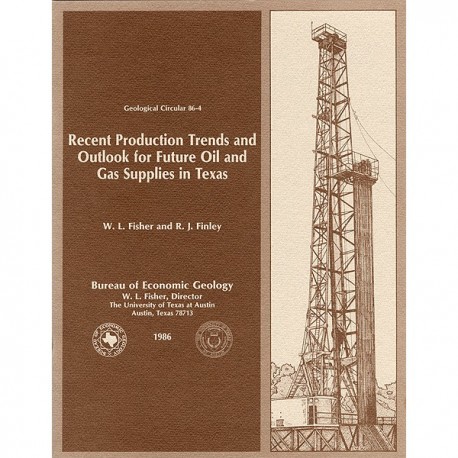
Recent Production Trends and Outlook for Future Oil and Gas Supplies in Texas
GC8604
For a downloadable, digital version: GC8604D.
GC8604. Recent Production Trends and Outlook for Future Oil and Gas Supplies in Texas, by W. L. Fisher and R. J. Finley. 31 p., 17 figs., 9 tables, 1 appendix, 1986. ISSN: 0082-3309. Print.
To purchase this publication as a PDF download, please order GC8604D.
ABSTRACT
Oil and gas production in Texas peaked in 1972, but the state still contributed 28 percent of oil production and 33 percent of gas production in the United States in 1984. The outlook for future oil and gas supplies in Texas can best be defined by analyzing the trends of the past 10 to 15 years.
For oil, the rate of annual production decline accelerated to 6.0 percent from 1972 through 1979, declined to 0.4 percent in 1984, but increased to 1.7 percent in 1985. Declines in reserve additions also slowed, from a rate of 8 percent in 1979 to an increase of 0.24 percent in 1984. Extension and infill drilling accounted for nearly three-fourths of reserve additions between 1973 and 1982. Favorable trends in reserve additions prevailed under the price levels of 1980 to 1985 but will not persist at prices of $10 to $14 per barrel.
A resource base of potentially producible mobile oil of 35 billion barrels exists in Texas beyond proved reserves. Much of this resource exists in carbonate reservoirs of the West Texas Permian Basin. If adequately realized, this target oil is sufficient to sustain production at minimal decline rates near those of 1983 to 1985. Additional resources of 75 billion barrels exist as residual and heavy oil, but recovery of this oil is highly sensitive to price and technology.
For all gas, average annual production decline between 1972 and 1983 was 4.8 percent. Production was up 3.5 percent in 1984, probably as depleted winter stocks were replaced, but declined 1.0 percent in 1985. Associated gas production increased at about 2 percent annually in 1980 to 1984 as the oil production decline rate slowed. Gas production from 1983 to 1986 has been negatively affected by a supply surplus, making production data a poor indicator of deliverability.
Gas reserves prior to 1980 were affected by substantial negative revisions but since that year have been relatively stable at nearly 50 Tcf. In Railroad Commission district 4 in South Texas, the most productive nonassociated gas district in the state, reserves increased an average of 2.5 percent annually from 1980 to 1984. Most other leading gas-producing districts have shown reserve declines. Low gas prices (at or less than $2.00/MMbtu in 1985 dollars) and the capability of industries or utilities to switch to low-priced oil in 1986 will bring about further declines in gas well completions, which were down 21.4 percent in 1985.
The long-term outlook for oil and gas production in Texas is positive despite the maturity of Texas as a hydrocarbon province. Remaining resources are substantial but will not be obtainable as easily extracted primary production. Increased geological and engineering understanding of oil and gas reservoirs, supported by favorable economic incentives and public policy, will be required to add additional reserves.
Keywords: oil, gas, reserves, resource assessment, production, hydrocarbon resources, Texas
Citation
Fisher, W. L., and Finley, R. J., 1986, Recent Production Trends and Outlook for Future Oil and Gas Supplies in Texas: The University of Texas at Austin, Bureau of Economic Geology, Geological Circular 86-4, 31 p.

